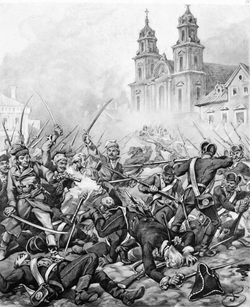Warsaw Uprising (1794)
The Warsaw Uprising of 1794 (also called the "Warsaw Insurrection") was started by a group of Polish people who lived in Warsaw. With help from the Polish Army, they tried to stop Russia from controlling the biggest city in Poland. It started on April 17, 1794, which was soon after Tadeusz Kościuszko's victory at an important battle.
Although the Russian army was larger, had better weapons, and killed many Polish people, Russian soldiers started to lose a lot of land and suffered from many deaths.
The Polish people had been preparing to fight in the uprising since the spring of 1793.[1] They managed to become very popular: they formed a large army of volunteers who were led by a shoemaker, Jan Kiliński.[2] Apart from this army, the most famous group to take part in giving the Polish people their freedom were the Poles who had been forced to join the Russian army.[3] A person who watched the fighting was a French artist, Jan Piotr Norblin, who drew pictures of the uprising.
Warsaw Uprising (1794) Media
General Stanisław Mokronowski
Warsaw Arsenal, on the left, was the scene of heavy fighting during the Uprising, as well as 35 years later, during the November Uprising (pictured).
A witness to the fighting was Jan Piotr Norblin (1740–1830), a French-born Polish painter who created a set of sketches and paintings of the struggle.
Brühl Palace in Warsaw.
Document of accession of the city of Warsaw to Kościuszko Uprising, signed on 19 April
References
- ↑ (in Polish) "Rozbicie spisku w Warszawie (Thwarting of the Conspiracy in Warsaw)". Patron. Jan Kiliński's School of Mogielnica. Retrieved 2006-06-27.[dead link]
- ↑ (in English) The Global Ramifications of the French Revolution. Cambridge: Cambridge University Press. 6 June 2002. pp. 59–60. ISBN 0-521-52447-4.
- ↑ (in English) "The Origin of the Formations". Arsenał, Association of Polish Regiments. 2006-01-06. Archived from the original on 2006-05-28. Retrieved 2006-06-19.









